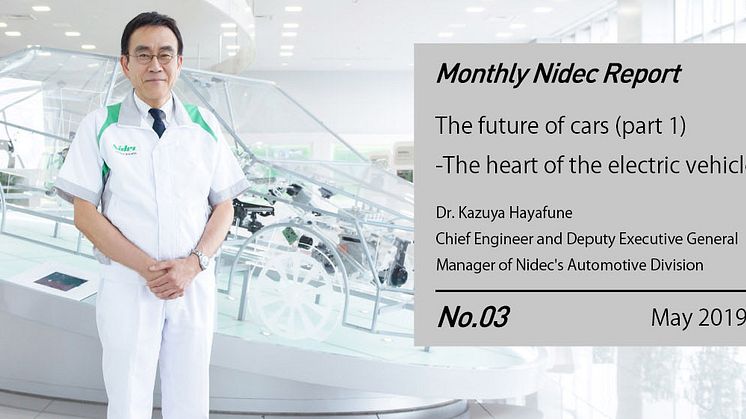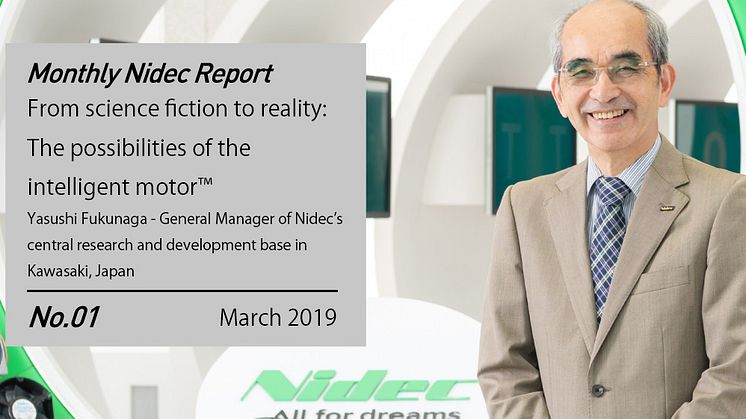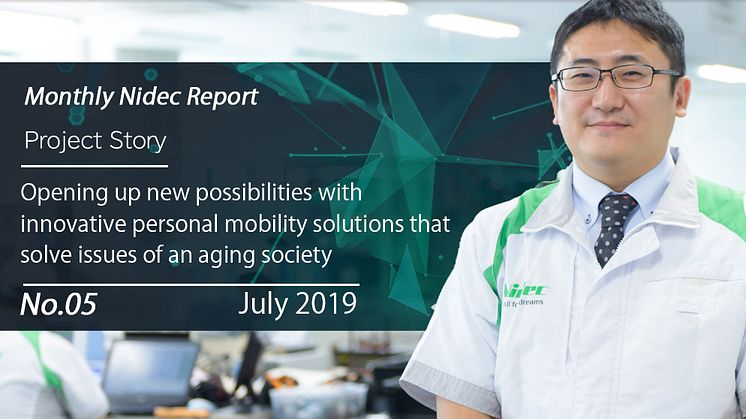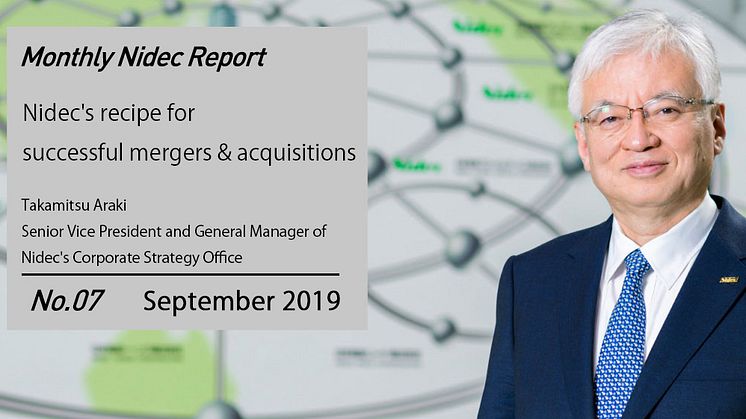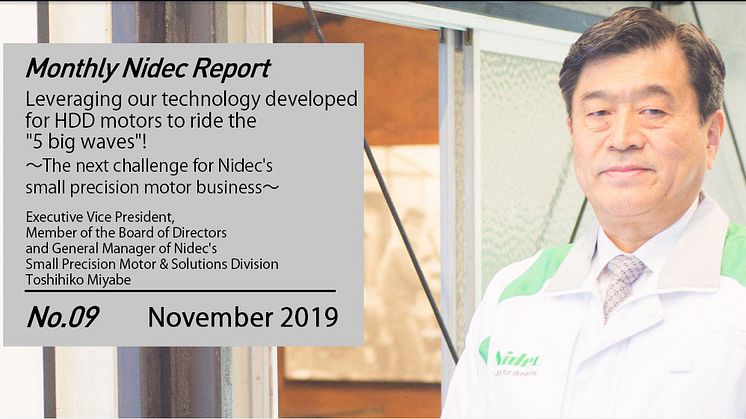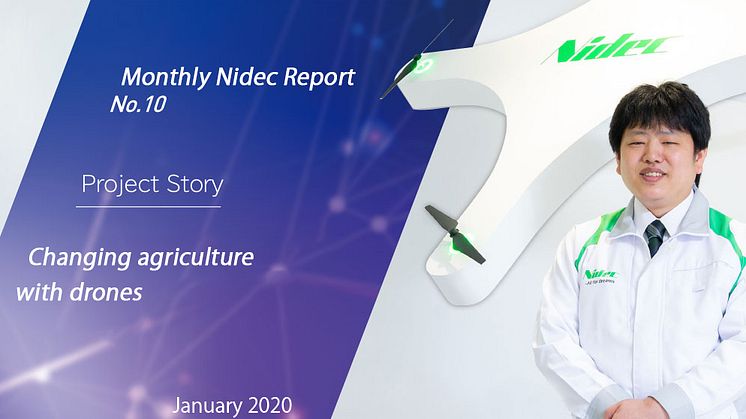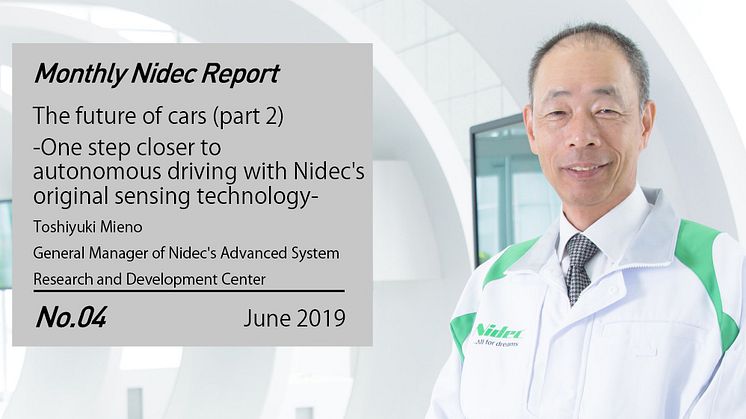
Blog post -
Monthly Nidec Report - One step closer to autonomous driving with Nidec's original sensing technology
The eyes of the world are focused on autonomous driving as companies around the globe push to develop technologies that contribute to a safer motorized society. One of these technologies, the world's smallest ADAS
1 sensing unit of its kind that integrates a monocular camera and a millimeter wave radar, was announced by the Nidec group in September 2017. In this area marked by intense competition, the fusion of the Nidec group's extensive component technologies with its technological expertise in electronic control is vital to success. Thus, Nidec's Advanced System Research and Development Center was born.
1ADAS, Advanced Driver-Assistance Systems, is a general term that refers to systems designed to assist the driver and increase safety, often through the use of radars, cameras and various other sensors.
As more and more new technologies make their way into cars we get closer and closer to fully autonomous driving

- What are some of the global trends in the development of autonomous driving technology?
The car is a very convenient tool that gives people mobility—the freedom to move—, but the safety of motorists and pedestrians alike must always be the number one priority. Accordingly, driver-assistance systems, and autonomous driving technologies, are generally developed with the aim of eliminating human error accidents. Japan—where Nidec is headquartered—in particular, is often referred to as an aging society, and there is strong demand for technologies that can reduce accidents caused by human error. In line with this thinking, vehicle safety assessment programs have been introduced in Japan, Europe and America to establish standards for safety functions. Markets related to autonomous driving are growing rapidly as automakers around the world design new cars that comply with these new standards.
Some examples of ADAS technologies that have already been implemented include: Autonomous Emergency Braking (AEB) systems that automatically apply the brakes when obstacles are detected in front of the car, Lane Keeping Assist (LKA) systems that prevent unwanted lane departure, and Adaptive Cruise Control (ACC) systems that allow the car to maintain a safe distance from vehicles ahead when driving. Fully autonomous driving—which is actively being pursued by various actors in the industry—is simply a matter of continuing along the same path and ultimately removing the human driver from the equation.
- What kind of technologies will be necessary to make autonomous driving reality?
A human is essentially doing three different things when driving a car: perceiving his or her surroundings, making decisions based on this information and operating the vehicle. When it comes to autonomous driving, the same three steps—perception, decision making and operation—have to be carried out by a machine instead. Thus, R&D into autonomous driving technology can generally be divided into these three categories.
Out of the three, perception in particular is seeing rapid progress right now. Of course, I am talking about the sensing technology that is necessary in order to interpret and understand the environment surrounding the car. In order for autonomous driving to become reality, accurate sensing of other vehicles, pedestrians and obstacles—even when there is reduced visibility due to unfavorable conditions like darkness, heavy rain or mist—is an absolute necessity; no decision-making AI or control technology, no matter how advanced, can make up for an inability to accurately understand the situation that the car is in. Hence, it can be said that sensing is the foundation of autonomous driving.
Sophisticated sensing through the integration of camera and radar technologies
- Tell us about the new integrated sensor fusion unit announced by Nidec Elesys in September 2017.
The most distinctive feature of this product is that it integrates two different sensors—a monocular camera and a millimeter wave radar—into a single unit, enabling advanced sensing that combines the advantages of both technologies. Cameras are particularly suited for image analysis applications like detecting traffic signs and the headlights of approaching cars, while radars, on the other hand, are better at measuring speeds and distances with their radio waves. Thus, utilizing the strengths of each sensor and integrating various information sources results in data that is optimal for autonomous driving. For example, by linking speed information from the radar with objects picked up by the camera it becomes possible to quickly detect merging cars from neighboring lanes.

- Are there any benefits of this integrated design in terms of cost?
Yes, this integrated approach lets the sensors share the same microcomputer and power supply equipment, so there are cost-related benefits as well. Also, the installation process, and by extension the car manufacturing process, is simplified greatly as the need to align the different sensors with each other is eliminated.
Placement inside the cabin made possible by a new millimeter-wave radar antenna
- What other benefits are there? You mentioned that the sensor unit is the smallest of its kind in the world.
Yes, it is quite small compared to conventional products. In fact, it is small enough to be installed behind the rear-view mirror inside the cabin. Traditionally, forward-looking sensors like millimeter-wave radars are usually placed behind the front grille, but, since this space is also used by many other devices and components, layout is always an issue. What's more, placing the radar behind the grille like this leads to other issues as well, like reduced accuracy due to buildup of dirt and snow. The radar also risks becoming misaligned as a result of minor collisions.
Why then, if there are so many issues, are conventional radars installed behind the grille? Well, it has to do with the limits of millimeter-wave radar technology; millimeter waves are weakened when they pass through glass, resulting in a shorter detection distance, so in order to achieve a sufficient detection distance you would have to increase the size of the antenna. However, doing so would risk obstructing the view of the driver if the radar is placed behind the windshield.
Our new horn antenna for millimeter-wave radars, developed independently by the Nidec group, overcomes this problem by adopting a special structure that makes it possible to turn up the sensitivity without having to significantly increase the size of the antenna. The performance is also remarkably high; when installed behind the windshield inside the car it can detect objects further than 200 meters in front of the car—just like a radar placed behind the front grille would—, and it has a wide angle of 90 degrees. The response from various automakers has been overwhelmingly positive and we have already received orders from one company that plans to use the radar in several of their vehicle models. Mass production started in autumn 2018.

 Millimeter-wave radars enjoy wide use due to not being susceptible to the effects of weather and low-light conditions, but they are not without their limitations. Conventional millimeter-wave radars tend to have a limited resolution to measure distance or angle of objects. In other words, they are unable to distinguish between two targets in the same direction that are close to each other. This has implications for ADAS applications that require high-resolution sensing as a combination of regular radars and laser radars with a higher resolution would have to be used to achieve the required performance.
Millimeter-wave radars enjoy wide use due to not being susceptible to the effects of weather and low-light conditions, but they are not without their limitations. Conventional millimeter-wave radars tend to have a limited resolution to measure distance or angle of objects. In other words, they are unable to distinguish between two targets in the same direction that are close to each other. This has implications for ADAS applications that require high-resolution sensing as a combination of regular radars and laser radars with a higher resolution would have to be used to achieve the required performance.To overcome this problem, we developed a new antenna that utilizes a technology called waffle-iron ridge waveguides. Our compact millimeter-wave radar unit equipped with this antenna achieves a resolution that is high enough to be able to distinguish between individual pedestrians in a crowd of people crossing the street. Our engineers are currently working on the final steps to commercializing the technology. I am confident that it will contribute quite a bit to the progress of autonomous driving. By the way, we are thinking about developing 5G communication antennas based on this new technology as well. This would enable efficient transmission of large volumes of data and open the door to other next-gen applications like connected cars. |

Procurement, R&D, sales—synergy on all fronts
The benefits of joining the Nidec group
- What kind of products were you developing at Nidec Elesys before you joined the Nidec group in 2014?
Before we joined the Nidec Group and became Nidec Elesys we used to be Honda Elesys—a company in the Honda group specializing in development of electronic control systems. We've been involved in automation technologies for quite some time. For example, back in 2002 we developed a collision avoidance system and an adaptive cruise control system by combining radar- and automotive control technologies. We were actually ahead of the times compared to the other players in the Japanese automotive industry. Also, at the time we had already started developing technologies for camera-based image recognition.

- How did things change when you became part of the Nidec group?
First of all, there was a lot of synergy from the start. For example, many of the parts that we used to procure from outside sources can be made inside the Nidec group; the camera module used in our sensor fusion unit is now supplied by Nidec Copal and the die casting equipment for the antenna—the most important part of the manufacturing process—is developed and made by Nidec’s global production engineering division. By insourcing the production of key components, we've been able to improve quality and increase cost competitiveness.
There is synergy in terms of R&D as well. For instance, the Nidec Center for Industrial Science, and the individual R&D departments of some companies in the group, are conducting research in various highly relevant fields like image processing technology. Also, the automotive division of Nidec Corporation and the company group's central research and development base carry out R&D into automotive control technologies and autonomous driving in general. Our mission here at the advanced system research and development center is to act as a hub for all of these activities and advance the development of new technologies comprehensively while working together with the various teams inside the company group. By doing so, we hope to promote even more synergy.
It goes without saying that the Nidec group’s vast global sales network proved very useful to us as well. With salespersons located all around the world, we can approach many more potential customers. Practically, there are pretty much no automakers left in the world that we haven’t contacted yet.

- The integrated sensor fusion product is an example of a solution in the "perception" category. Do you have any plans to venture into the “decision making” and “operation” categories as well?
Yes! We plan to start supplying an ADAS ECU (electronic control unit) as a set with our new ADAS sensor that entered mass production in autumn 2018. As I mentioned, Nidec Elesys used to be an affiliate of an automaker, so development of ECUs that control the operation of advanced driver-assistance systems is one of the company's strong sides. We also have access to proprietary steering- and drive control technologies through our cooperation with other companies in the Nidec group. Some of our customers prefer to combine their own control technologies with the platform provided by Nidec though, so we always try to be flexible in our development to make sure that we can respond to the diverse needs of our customers. This flexibility is another one of our strengths.
Using our sensor technology as a springboard into the large market for autonomous driving
- So, you have your eyes set not only on sensing technology but also on the larger market for autonomous driving technology?
That’s right. Sensing—the ability to perceive the external world—makes up the base of autonomous driving, but the market for autonomous driving technology in its entirety is of course even bigger. Tier 1 companies and other automotive suppliers all around the world are making large R&D investments and getting ready for the fierce competition in the enormous market. The Nidec Group's strategy is to leverage new technologies like our integrated sensor fusion unit and our proprietary millimeter-wave radar antenna to break into the market and then increase our offering from there.
In addition to sensing technology, we're also researching other areas that are closely tied to autonomous driving such as high-accuracy mapping of road information, various GPS applications and deep learning. As a whole, the Nidec group has an extensive lineup of automotive products—including traction motors, electric power steering motors and brake motors—that cover all of the basic functions of "driving," "turning" and "stopping." I'm not only talking about technological potential; we've actually built a test car and equipped it with our new products so that we can see them in action on a test course. Moving forward, we want to strive towards being a fresh breath of air into the automotive industry with new original products that play to Nidec's greatest strength—designing extremely compact and lightweight products.
 Autonomous driving and vehicle electrification are two large-scale trends that are transforming the automotive industry. As a result of this change that has been called a once-in-a-hundred-years technological revolution, the industry is opening up to new players and presenting business opportunities for numerous companies from other fields like IT. However, ensuring that the cars operate safely in practice is easier said than done. It's not simply a matter of buying and assembling a couple of components. The "soul" of the car, so to speak, is also important; you have to formulate safety algorithms and turn them into software that is installed in the various parts. This can only be done through experience out in the real world where the roads are used by a variety of different vehicles and pedestrians. With more than 15 years of experience, the Nidec group has accumulated vast amounts of software assets, giving us a competitive edge against new rivals entering the market. Moving forward, we hope to leverage this advantage to contribute to the evolution of autonomous driving technology. |
